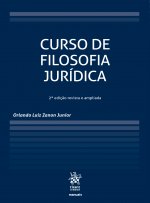Categorias
- Criminologia
- Direito à Saúde
- Direito Administrativo
- Direito Ambiental
- Direito Civil
- Direito Comercial
- Direito Constitucional
- Direito do Trabalho
- Direito e Psicanálise
- Direito e Sociedade
- Direito Internacional
- Direito Penal
- Direito Processual Civil
- Direito Processual Penal
- Direito Tributário
- Romance Jurídico
Curso de Filosofia Jurídica - 2ª edição

Título: Curso de Filosofia Jurídica - 2ª edição
Autor: Orlando Luiz Zanon Junior
Código de Barras: 9788594773449
Páginas: 460
Valor: R$ 130,00
ISBN: 9788594773449
- Descrição
- Características
- Sumário
As duas partes deste curso abrangem, primeiro, aspectos da história da filosofia que permitem conhecer o desenvolvimento do pensamento ocidental, com notas sobre discussões referente à ética e à política, e, segundo, os fundamentos específicos da filosofia jurídica, mediante a abordagem de seus dois paradigmas principais (Jusnaturalismo e Positivismo Jurídico) e das propostas de superação mais difundidas (as correntes Pós-positivistas), mediante um corte pelas quatro plataformas centrais da ciência jurídica, que são as teorias das fontes, do ordenamento, da norma e da decisão.
Não só os acadêmicos interessados na filosofia geral e jurídica encontrarão utilidade para o presente curso, haja vista que apresenta conteúdo relevante também aos que pretendem prestar concursos públicos da área jurídica e, assim, precisam adquirir conhecimentos sobre temas humanísticos e filosóficos. O texto igualmente é recomendado aos profissionais jurídicos (juízes, advogados, promotores, defensores etc) cuja intenção é revisar os entendimentos sobre os elementos teóricos que, de forma consciente ou mesmo meramente intuitiva, acabam por determinar a sua prática de atuação, porquanto servem de base de sustentação do sistema jurisdicional.
Título: Curso de Filosofia Jurídica - 2ª edição
Autor: Orlando Luiz Zanon Junior
Código de Barras: 9788594773449
Páginas: 460
Valor: R$ 130,00
ISBN: 9788594773449
SUMÁRIO
INTRODUÇÃO . . . . . . . . . . . . . . . . . . . . . . . . . . . . . . . . . . . . . . . . . 13
CAPÍTULO 1 - FILOSOFIA GERAL . . . . . . . . . . . . . . . . . . . . . . . . . . 17
1.1. CONCEITOS DAS MODALIDADES DE CONHECIMENTO . . . . . . 17
1.2. FILOSOFIA ANTIGA . . . . . . . . . . . . . . . . . . . . . . . . . . . . . . . . . . . . . . . . 21
1.2.1. A origem da filosofia . . . . . . . . . . . . . . . . . . . . . . . . . . . . . . . . . . . . . . . . . . 21
1.2.2. Subperíodo pré-socrático . . . . . . . . . . . . . . . . . . . . . . . . . . . . . . . . . . . . . . . 24
1.2.3. Subperíodo socrático . . . . . . . . . . . . . . . . . . . . . . . . . . . . . . . . . . . . . . . . . . 29
1.2.4. Subperíodo helenístico . . . . . . . . . . . . . . . . . . . . . . . . . . . . . . . . . . . . . . . . . 51
1.3. FILOSOFIA MEDIEVAL . . . . . . . . . . . . . . . . . . . . . . . . . . . . . . . . . . . . . 59
1.3.1. Patrística . . . . . . . . . . . . . . . . . . . . . . . . . . . . . . . . . . . . . . . . . . . . . . . . . . . 61
1.3.2. Escolástica . . . . . . . . . . . . . . . . . . . . . . . . . . . . . . . . . . . . . . . . . . . . . . . . . . 62
1.4. FILOSOFIA MODERNA . . . . . . . . . . . . . . . . . . . . . . . . . . . . . . . . . . . . . 68
1.4.1. Renascimento . . . . . . . . . . . . . . . . . . . . . . . . . . . . . . . . . . . . . . . . . . . . . . . 68
1.4.2. Revolução científica . . . . . . . . . . . . . . . . . . . . . . . . . . . . . . . . . . . . . . . . . . . 69
1.4.3. Iluminismo . . . . . . . . . . . . . . . . . . . . . . . . . . . . . . . . . . . . . . . . . . . . . . . . . 77
1.4.4. Romantismo . . . . . . . . . . . . . . . . . . . . . . . . . . . . . . . . . . . . . . . . . . . . . . . . 94
1.4.5. Idealismo . . . . . . . . . . . . . . . . . . . . . . . . . . . . . . . . . . . . . . . . . . . . . . . . . . . 96
1.4.6. Positivismo . . . . . . . . . . . . . . . . . . . . . . . . . . . . . . . . . . . . . . . . . . . . . . . . 104
1.4.7. Utilitarismo . . . . . . . . . . . . . . . . . . . . . . . . . . . . . . . . . . . . . . . . . . . . . . . . 106
1.4.8. As críticas de Nietzsche . . . . . . . . . . . . . . . . . . . . . . . . . . . . . . . . . . . . . . . 108
1.4.9. Pragmatismo . . . . . . . . . . . . . . . . . . . . . . . . . . . . . . . . . . . . . . . . . . . . . . . 110
1.4.10. Advento da sociologia . . . . . . . . . . . . . . . . . . . . . . . . . . . . . . . . . . . . . . . . 120
1.5. FILOSOFIA CONTEMPORÂNEA . . . . . . . . . . . . . . . . . . . . . . . . . . . . 136
1.5.1. Fenomenologia . . . . . . . . . . . . . . . . . . . . . . . . . . . . . . . . . . . . . . . . . . . . . 136
1.5.2. Existencialismo . . . . . . . . . . . . . . . . . . . . . . . . . . . . . . . . . . . . . . . . . . . . 139
1.5.3. Hermenêutica . . . . . . . . . . . . . . . . . . . . . . . . . . . . . . . . . . . . . . . . . . . . . . 143
1.5.4. Filosofia da linguagem . . . . . . . . . . . . . . . . . . . . . . . . . . . . . . . . . . . . . . . 147
1.5.5. Neopragmatismo . . . . . . . . . . . . . . . . . . . . . . . . . . . . . . . . . . . . . . . . . . . 152
1.5.6. Desenvolvimentos na economia . . . . . . . . . . . . . . . . . . . . . . . . . . . . . . . . 155
1.5.7. Desenvolvimentos na filosofia da ciência . . . . . . . . . . . . . . . . . . . . . . . . 159
1.5.8. Desenvolvimentos na Teoria Política . . . . . . . . . . . . . . . . . . . . . . . . . . . . 173
1.5.9. Outros movimentos da época contemporânea . . . . . . . . . . . . . . . . . . . . . 175
CAPÍTULO 2 - FILOSOFIA JURÍDICA . . . . . . . . . . . . . . . . . . . . . . . 183
2.1. NOÇÕES INTRODUTÓRIAS . . . . . . . . . . . . . . . . . . . . . . . . . . . . . . . 183
2.1.1. Conceito de direito . . . . . . . . . . . . . . . . . . . . . . . . . . . . . . . . . . . . . . . . . . 183
2.1.2. Conceito de ciência jurídica (ou teoria do direito) . . . . . . . . . . . . . . . . . . 185
2.1.3. Verdade paradigmática . . . . . . . . . . . . . . . . . . . . . . . . . . . . . . . . . . . . . . . 196 2.2. JUSNATURALISMO . . . . . . . . . . . . . . . . . . . . . . . . . . . . . . . . . . . . . . . 200
2.2.1. Histórico . . . . . . . . . . . . . . . . . . . . . . . . . . . . . . . . . . . . . . . . . . . . . . . . . . 200
2.2.2. Síntese das teses centrais do jusnaturalismo . . . . . . . . . . . . . . . . . . . . . . . . 205
2.2.3. Síntese das críticas ao jusnaturalismo . . . . . . . . . . . . . . . . . . . . . . . . . . . . . 208
2.3. POSITIVISMO JURÍDICO . . . . . . . . . . . . . . . . . . . . . . . . . . . . . . . . . . 212
2.3.1. O enfoque juspositivista . . . . . . . . . . . . . . . . . . . . . . . . . . . . . . . . . . . . . . 212
2.3.2. A Teoria Pura de Kelsen . . . . . . . . . . . . . . . . . . . . . . . . . . . . . . . . . . . . . . . 215
2.3.3. O conceito de direito de Hart . . . . . . . . . . . . . . . . . . . . . . . . . . . . . . . . . . 223
2.3.4. O positivismo jurídico de Bobbio . . . . . . . . . . . . . . . . . . . . . . . . . . . . . . . 230
2.3.5. O garantismo jurídico de Ferrajoli . . . . . . . . . . . . . . . . . . . . . . . . . . . . . . . 242
2.3.6. Síntese das teses centrais do juspositivismo . . . . . . . . . . . . . . . . . . . . . . . . 258
2.3.7. Síntese das críticas ao juspositivismo . . . . . . . . . . . . . . . . . . . . . . . . . . . . . 265
2.4. PÓS-POSITIVISMO . . . . . . . . . . . . . . . . . . . . . . . . . . . . . . . . . . . . . . . 268
2.4.1. As correntes pós-positivistas . . . . . . . . . . . . . . . . . . . . . . . . . . . . . . . . . . . . 268
2.4.2. A teoria liberal de Dworkin . . . . . . . . . . . . . . . . . . . . . . . . . . . . . . . . . . . . 277
2.4.3. A teoria hermenêutica de Streck . . . . . . . . . . . . . . . . . . . . . . . . . . . . . . . . . 314
2.4.4. A teoria pragmática de Posner . . . . . . . . . . . . . . . . . . . . . . . . . . . . . . . . . . 338
2.4.5. A teoria discursiva do direito de Alexy . . . . . . . . . . . . . . . . . . . . . . . . . . . . 361
2.4.5.1. Características . . . . . . . . . . . . . . . . . . . . . . . . . . . . . . . . . . . . . . . . . . . . . . 361
2.4.5.2. A ponderação de princípios jurídicos . . . . . . . . . . . . . . . . . . . . . . . . . . . . . 380
2.4.6. Síntese das proposições pós-positivistas . . . . . . . . . . . . . . . . . . . . . . . . . . . 389
2.5. OUTRAS ESCOLAS JURÍDICAS . . . . . . . . . . . . . . . . . . . . . . . . . . . . . 391
CAPÍTULO 3 - A TEORIA COMPLEXA DO DIREITO . . . . . . . . . 405
3.1. NOÇÕES INTRODUTÓRIAS . . . . . . . . . . . . . . . . . . . . . . . . . . . . . . . 405
3.2. ÉTICA MORAL E DIREITO . . . . . . . . . . . . . . . . . . . . . . . . . . . . . . . . . 417
3.2.1. Conceitos . . . . . . . . . . . . . . . . . . . . . . . . . . . . . . . . . . . . . . . . . . . . . . . . . 417
3.2.2. Relacionamento . . . . . . . . . . . . . . . . . . . . . . . . . . . . . . . . . . . . . . . . . . . . . 425
3.3. TEORIA DAS FONTES JURÍDICAS . . . . . . . . . . . . . . . . . . . . . . . . . . 428
3.3.1. Conceitos de fontes jurídicas e de modos de produção . . . . . . . . . . . . . . . . 428
3.3.2. Tipologia . . . . . . . . . . . . . . . . . . . . . . . . . . . . . . . . . . . . . . . . . . . . . . . . . . 430
3.3.3. Características . . . . . . . . . . . . . . . . . . . . . . . . . . . . . . . . . . . . . . . . . . . . . . 433
3.4. TEORIA DO ORDENAMENTO JURÍDICO . . . . . . . . . . . . . . . . . . . 440
3.5. TEORIA DAS NORMAS JURÍDICAS . . . . . . . . . . . . . . . . . . . . . . . . . 443
3.6. TEORIA DAS DECISÕES JURÍDICAS . . . . . . . . . . . . . . . . . . . . . . . . 448
REFERÊNCIAS . . . . . . . . . . . . . . . . . . . . . . . . . . . . . . . . . . . . . . . . . 451

Você também pode gostar de:
-
A Presunção de Má-Fé na Fraude Contra Credores

R$ 60,00
-
A criminalização midiática do sex offender

R$ 35,00
-
Direito Penal de Exceção

R$ 60,00
-
LÓGICAS DE (DES)ORDEM - vol. 1 Entre o desejo de Ordem e as Ordens Concretas

R$ 120,00